Check out our growing collection of motel postcards from this state.
This page is a work in progress, with all of the accompanying opportunities for misspelling and factual error. If you have any comments, suggestions, or concerns, please feel free to email us.
Depending on your budget, you can stay in the Show Boat Room, the Country Gentleman Living Room, the Romance Room, even an Antique Car Room. We chose the Fabulous Fifties Room, assuming that we'd get some sort of chrome and neon affair with maybe a touch of Formica. Instead, we found framed prints from Harper's Weekly, delicate light fixtures featuring tiny pink hanging crystal beads, and an elegant Victorian parlor seat that invites you to curl up with a loved one. Yep, they must have meant the fabulous 1850s. Bonus! Be warned though, the Madonna Inn is not to be consumed if you've got a weak stomach. The place simply pulsates with gaudy cherubs, intricate wood carvings, voluptuous stone walls, and about a thousand shades of pink - pink door frames, pink stationary, pink sugar.
Even if you can't afford to stay, you can window-shop at fancy boutiques, grab some iced tea garnished with rock candy in a copper and brass-laden diner, and visit one of the few bathrooms that may justifiably be termed, "world famous." The men's room, downstairs from the Gold Rush Dining Room, offers an artificial waterfall in lieu of a loo (though more traditional accommodations are available). The Madonna Inn resides proudly among such national treasures of tacky pleasures as Wall Drug in South Dakota and South of the Border in South Carolina. Don't be surprised if you find yourself staring dumbstruck at all the Madonna's relentlessly pink, gilded glory. Everyone does.
While in San Luis Obispo you can visit the very first motel. On that site in 1925, Arthur Heinman invested about $80,000 into the Milestone Motel - eventually renamed the Motel Inn. Built in Spanish revival, the Motel Inn invites affectionados to visit a vision of crass commercialism, derivative architecture, and bypassed dreams. Still, we cannot help but wander the parking lot with some measure of reverence. There are so few genuine "firsts" anymore - but the Motel Inn is indeed the first motel: a quick stop along the highway designed to eschew the ponderous ritual of hotel lobby check in and management surveillance. Highway voyagers could imagine themselves as upscale hobos, cruising along the winding road - stopping for a while, awaiting the dew of the next morning - and heading again toward the horizon. Today, the Motel Inn awaits contractors and preservationists who hint about restoration. But no one is sure when that day will come. You can compare a postcard image to our recent recent photograph. We've also placed a beautiful linen view in our postcard section.
In San Miguel, past the abandoned Purina chow plant, mariachi music plays a mournful syncopation. The grass is brown at the Shady Rest and crackles under the hundred degree heat of a noon day sun. Abandoned businesses and overgrown sidewalks follow the railroad past the nearly abandoned motel. Between cabins 8 and 10, a motley collection of dudes in sweat-stained t-shirts - migrant workers making money off the vineyards nearby - play cards atop a wooden cable spool. Jenny grabs her shot of a sunburned cabin and its garden of wilted corn. Down the road at Danny's cafe, the cashier in pink sporting a soft cast on her wrist nearly cackles: "You don't want to know what goes on down at the Shady Rest." Winking to a friend on my side of the counter: "Now, remember when we took that trip to Nevada, shooting hotels and motels in black and white - now that's photography." Turning to face me directly, she continues, "What I wanna do is take pictures of clotheslines. Travel the country shooting clotheslines. You can tell a lot about people by the clothes they hang, old people, young people, diapers..." Back on highway 101, curved signs with singular bells mark the Camino Real snaking its way through the brutal fields.
Heading north - past Silicon Valley and the City by the Bay - we stop at the Trees of Mystery (in Klamath) and meet Paul Bunyan and Babe the Blue Ox for seventeen bucks. Of course, after "driving through" the Chandelier tree a few miles back, it's kind of nice to see redwoods in their more or less natural state. Sure, some look like cathedrals and candelabras, but only if you really want them to. While Jenny and I sift through the mounds of postcards, trinkets, and geegaws in the gift shop (placed strategically at the end of the Mystery Trail), Vienna peppers the talking Paul statue with questions. He winks his mechanical eye and waves us back onto the highway. Near the Oregon coast, south of Crescent City, we find the Ocean Way Motel. Carports and huge picture windows cannot compete with the sound of crashing waves just over the distance. Back on the highway, we follow lumbering airstream trailers and pickups that advertise local politics on their bumpers ("Hatchery Fish are Keepers")
Summer 2000, Highway 99: Hewn from the sand and locked down desert factories, Bakersfield is hardly an oasis in the desert. Rather, we find a heat-stroke blur of dusty parking lots, strained power lines, and chipped-paint doorways. It takes little time to locate the business loop of 99 and drain into the slow moving current of cars on Union Street and the Park Motel. Room 14 features a lonely display of brandy bottles, six in a row. The occupant's beat up Oldsmobile sports a flat tire and a rusty frame. Next door, eighties country music slides out an open door. The unconscious woman crashed on her mattress won't be going anywhere for a while.
 If you're reading this page, chances are that you like your lodgings clean, quirky, and cheap. In a pinch, clean may be replaced by extra doses of quirky, but cheap is pretty important on the road. Well, if you're willing to abandon that principle for one night, visit the Madonna Inn on 101 just south of San Luis Obispo. Simply put, you have to stay here one night of your life. It's that cool. Our fairly basic room set us back about 128 bucks, and we didn't even stay in the famed Caveman Room or the Swiss Chalet Room. That's right, every room - 109 of them - has some sort of theme, most dreamed up by Phyllis Madonna who, with her husband Alex, meticulously crafted this rambling inn over the past four decades.
If you're reading this page, chances are that you like your lodgings clean, quirky, and cheap. In a pinch, clean may be replaced by extra doses of quirky, but cheap is pretty important on the road. Well, if you're willing to abandon that principle for one night, visit the Madonna Inn on 101 just south of San Luis Obispo. Simply put, you have to stay here one night of your life. It's that cool. Our fairly basic room set us back about 128 bucks, and we didn't even stay in the famed Caveman Room or the Swiss Chalet Room. That's right, every room - 109 of them - has some sort of theme, most dreamed up by Phyllis Madonna who, with her husband Alex, meticulously crafted this rambling inn over the past four decades.
 Running roughly parallel to Interstate 101, state Highway 82 transforms itself for a time into Monterey Highway south of San Jose before assuming the path of El Camino Real heading north toward San Francisco where it will rejoin 101. Along this slight detour, we find plenty of wonderful sites. Near Santa Clara University, the Motel Sterling comes into view. When shooting neon, it's easy to ignore the painted sign underneath - a rough swab of red and blue and green to accentuate the tubes of glowing gas. Tonight a little girl peers out the window. The scent of curry drifts along the breeze.
Running roughly parallel to Interstate 101, state Highway 82 transforms itself for a time into Monterey Highway south of San Jose before assuming the path of El Camino Real heading north toward San Francisco where it will rejoin 101. Along this slight detour, we find plenty of wonderful sites. Near Santa Clara University, the Motel Sterling comes into view. When shooting neon, it's easy to ignore the painted sign underneath - a rough swab of red and blue and green to accentuate the tubes of glowing gas. Tonight a little girl peers out the window. The scent of curry drifts along the breeze.
![[camera]](camera.gif) Ocean Way
Ocean Way
![[camera]](camera.gif) Trails Inn
Trails Inn
![[camera]](camera.gif) Desert Inn
Desert Inn

At the El Morocco, a man yells from his window, "Why are you taking pictures?" Jenny answers, "It's our hobby." He seems satisfied, but a motel worker comes out with a raised paint brush: "you want a hobby," she motions, "I got a hobby for you." At the Travelers Motel, we spy intermittent carports stuffed with an icemaker, some chairs, and trash cans. This kind of pull-in site, typically built in the 1930s, is just the sort you'll find hanging onto the ragged remnants of pre-interstate towns. We stroll around for a while before turning a lazy arc onto the road. Cruising by crumbling deco storefronts and renovated houses turned into highway tabernacles, we share the strip with nouveux Harley enthusiasts, skinhead wannabes with weekend tattoos, and genuinely scary desperados. Up and down the road, we earn some suspicious looks ourselves. To motel managers, their cleaning ladies peering out from slightly ajar doorways, we must be INS agents or health inspectors or worst of all, touristas out to grab a quick photo and run back to our air-conditioned lives. Come to think of it, with our tacky k-mart "Hawaiian" t-shirts and late model car, there may be some point in the silent indictment we find by the side of the road.
After a while, we head east toward Blythe, on the edge of the California/Arizona border. This town offers a welcome respite from I-10's eastward trek through the miles of scrub, desert, and dust devils. Dropping onto Hobson Street, we grab a sundae at the Courtesy Coffee Shop. You'll recognize it by the twin palm trees growing through its googie facade. This Jetsons-meets-Flintstones restaurant is a popular gathering spot for dozens of local farmers. Faces lined by years of outdoor work, they joke and jab with easy camaraderie while the cars race by. Later on, after grabbing a great meal at Steaks and Cakes, we shoot the Blue Line motel and trailer park. While Jenny experiments with a starlight filter, a cop passes by a couple times before pulling up. Hopping out of her 4X4, she asks: "Excuse me, what are you doing?" It seems that Blythe gets more than its share of private investigators, insurance adjusters and other snoops. We seem harmless enough though and, before long, we're alone on the road once more.
![[camera]](camera.gif) Park Motel
Park Motel
![[camera]](camera.gif) El Morocco
El Morocco
![[camera]](camera.gif) Blue Line Motel
Blue Line Motel
Back in the summer of 1996, we took a trip along route 66. Here are our recollections from the California portion of the drive: We enter California through a strict agricultural inspection station - made all the more tight by our obviously road-weary appearance and Ohio tags. For our route 66 journey, Needles is the end of the line. Our schedule has forced us to retire here, before heading north to Vegas and then back east. Nonetheless, there is plenty to see. The most obvious vision is the heat that rises from the pavement in glimmering waves. Locals say the mercury topped 128 degrees a couple weeks ago.
Set under a large veranda with pale green posts for support, the 66 Motel greets us on the left of the main street through town. There's an old wooden bench next to room number three. It's held down by curved metal bolts. In the corner, a cactus sits in a pot of stones. Across the street, we visit the Trails Inn (formerly the Palms Motel). There's an ancient Phillips 66 pump in front of the office. Built in the 1930s, each room is an individual cabin. In the office, Jean explains how the owner has combed auctions and antique stores looking for pictures, furniture, and even those old bathtubs with feet in a restoration effort aimed at evoking unique memories of their prime. "Most of the motels you go into, every room looks exactly the same - the fixtures and everything look the same. These are not. They're all different." The Desert Inn is well named. It is boarded up and abandoned. Pigeons sit atop the sign next to a single blinking red light over the intersection.
Over at the Sage Motel, with a pool table that rents for four bucks an hour, the owner explains that most of his residents pay by the week. Housing is hard to come by, or so it seems. Later, we pass by the Le Brun Motel and Public Laundromat. Here, Jean's point is proven. Each room looks exactly the same as the other, with an identical bush and little brick wall next to the walkway. Only the windows suggest a hint of originality; some are shielded by curtains, others with blinds. Our first drive across the Mother Road ends with the Kiva Motel ("we reserve the right to refuse service to anyone"). This double-decker in green and white is slumped and tired, like us. A guy steps out of room fourteen with a Big Gulp in his hand and stares over the metal rail horizon. I wonder if he's a king in this domain.
![[Route 66 Motel]](calroute66motel.jpeg) During a 1999 visit to the Mohave, we visit Barstow - further along the highway before it drops into Los Angeles and the Santa Monica pier. Barstow features the El Rancho Motel and its towering sign set across twin pylons. Come by day and you'll notice in the parking lot a hand-painted map leading you across the length of the Mother Road, from Illinois to California. By nightfall, stop by Barstow Station if you hunger for a hurriedly manufactured McDonalds burger in a freshly repainted locomotive. Leaning against the wall, peer down the road as the neon twinkles in the dusty evening. Around the bend, you catch sight of the Route 66 Motel under renovation by Ved and Mridu Shandil. It's a delightful place on the grow.
During a 1999 visit to the Mohave, we visit Barstow - further along the highway before it drops into Los Angeles and the Santa Monica pier. Barstow features the El Rancho Motel and its towering sign set across twin pylons. Come by day and you'll notice in the parking lot a hand-painted map leading you across the length of the Mother Road, from Illinois to California. By nightfall, stop by Barstow Station if you hunger for a hurriedly manufactured McDonalds burger in a freshly repainted locomotive. Leaning against the wall, peer down the road as the neon twinkles in the dusty evening. Around the bend, you catch sight of the Route 66 Motel under renovation by Ved and Mridu Shandil. It's a delightful place on the grow.
In Summer 2000, we visited the Wigwam Motel in Rialto. The teepees, painted yellowish brown and striped with various shades of pink and blue and turquoise, wrap around an empty kidney shaped pool with rust-colored grass that burrows through the concrete cracks. The Rialto wigwam sidles Foothill Boulevard, the local incarnation of route 66, on its way to the LA basin. The marquee still invites its guests to "do it in a tee pee" but hourly rates no longer appear on the business cards. As usual, the manager looks warily through a gated doorway. We can take pictures, but we have to ask first. As we ask for a postcard, the manager rolls her eyes: "No, we have no postcards. So many people drive in, take photos so we can have one made, but they never send one. They promise, but they never send one."

Since losing its designation as a national highway, Route 66 has enjoyed a remarkable resurgence as people around the world discover its mystique. We've driven more than two thousand of its miles and still can't really understand why. I can only offer a guess. Unlike the endless superslabs that pierce this nation, the old highway never forgot the little towns that gave it life. The shady characters out to make a buck, the lost souls trying to get home, the families who never stopped at the truly tacky motels, the adventurers who renewed themselves with every curve - all of them found a place in transit. For them, and for us, Route 66 became an end beyond the means. And like the western horizon that pulled us toward the sun, that end only promises a new beginning for every person who comes here.
Check out our growing collection of motel postcards from this state.
Return to the lobby.
All photographs copyright © Jenny Wood. Text copyright © Andy Wood.